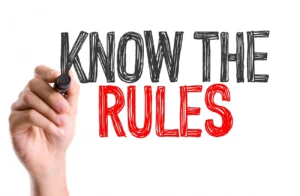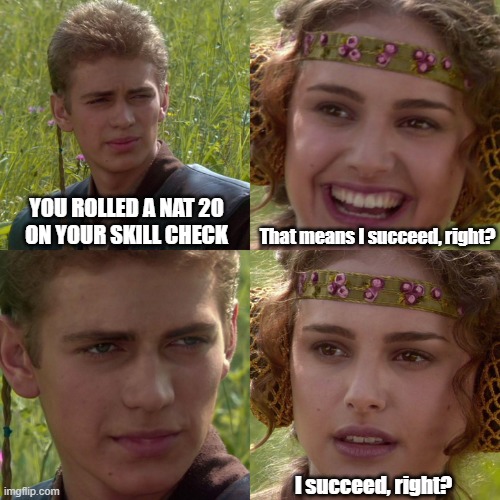 Part of an ongoing series of 5e Rules notes.
Part of an ongoing series of 5e Rules notes.
This is another thing that can engender confusion until it gets spelled out plainly, especially since it’s about something that has changed over various D&D editions, varies with other D20-based games, and has been house-ruled for eons.
What happens when you roll a natural (that’s the face showing on the die) 20 on a d20? What happens when you roll a natural 1?
When is a die roll a different die roll?
There are, in 5e, three types of d20 rolls:
- Attack rolls — rolls you make to successfully hit with an attack (against a given Armor Class (AC)).
- Ability Checks — rolls you make to check against an ability or skill to see if you succeed in your attempt (against a given Difficulty Class (DC)).
- Saving Throws — rolls you make to avoid or minimize the effect of a spell or other environmental hazard (against a given DC).
These are all done with a d20, but, despite that, each is treated independently in the rules.
For example, the Rogue’s Reliable Talent class ability (PHB 96) says “Whenever you make an ability check that lets you add your proficiency bonus, you can treat a d20 roll of 9 or lower as a 10.” That applies only to Ability Checks, not Saves or Attacks.
When is a crit not a crit?
This has a more global aspect. On Attacks (only!),
- a naturally rolled 20 is always a hit (and a critical hit, at that), regardless of modifiers or the target’s Armor Class.
- a naturally rolled 1 is always a miss, regardless of modifiers or the target’s Armor Class. (5e does not have a “fumble” rule.)
This auto-hit or auto-miss rule, though, does not apply to Saves or Ability Checks. For example, a natural 20 on a Saving Throw does not guarantee success. In fact, it just means that you have met or beat any DC of 20 or below. If the DC is 25, it doesn’t, Rules-As-Written, mean a thing other than you did not save.
That said …
Most DMs will do something to recognize a natural 20 (especially if it’s called to their attention), and sometimes a natural 1 as well, on a Save or Ability Check, even if the RAW doesn’t call for it.
This might be as simple as something narrated, calling out (without game effect) the natural beauty of the thing you did that you rolled a nat 20 on … or the gob-smacking ineptitude of the thing you did that you rolled a nat 1 on.
You dive for cover from the dragon’s breath, but mis-judge and fly through its center instead. You take [the standard] damage, but you can hear the dragon actually laughing at you.
Sometimes they may even given you a partial success for that nat 20.
You don’t manage a clean landing — but you’re on your feet, even if you’re going to be at half-speed next round.
or
Your valiant effort doesn’t succeed, but it came closer than you thought it would — take an Inspiration.
But don’t count on that, unless the DM is house-ruling something of that sort as a normal case.


One thought on “D&D 5e Rules – Rolls, High and Low!”